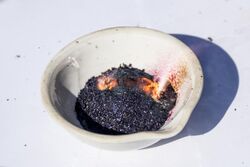Chemistry:Glycerol and potassium permanganate
The chemical redox reaction between potassium permanganate and glycerol[1][2][3][4][5][6] is often used to demonstrate the powerful oxidizing property of potassium permanganate, especially in the presence of organic compounds such as glycerol. The exothermic (heat producing) reaction between potassium permanganate (KMnO4), a strong oxidizing agent, and glycerol (C3H5(OH)3), a readily oxidised organic substance, is an example of an experiment sometimes referred to as a "chemical volcano".[7][8]
Explanation
Potassium permanganate (KMnO4) is a dark violet colored powder. Its reaction with glycerol (commonly known as glycerin or glycerine) (C3H5(OH)3) is highly exothermic, resulting rapidly in a flame, along with the formation of carbon dioxide and water vapor:
14 KMnO4(s) + 4 C3H5(OH)3(l) → 7 K2CO3(s) + 7 Mn2O3(s) + 5 CO2(g) + 16 H2O(g).[1][3][4][5][6]
Crystalline potassium permanganate (KMnO4) is placed in an evaporating dish. A depression is made at the center of the permanganate powder and glycerol liquid is added to it. The white smoke-like vapor produced by the reaction is a mixture of carbon dioxide gas and water vapor. Since the reaction is highly exothermic, initial sparking occurs, followed by a lilac- or pink-colored flame.[9] When energy or heat is added to electrons, their energy level increases to an excited state. This state is short-lived, and once the electrons release the energy, they return to their normal energy levels.[2] During this process the energy is visibly observed as light.[10] When the reaction is complete, it leaves behind a grayish solid with green regions.[1][3][4][5][6]
Gallery
See also
- Carbon snake
- Sugar snake
References
- ↑ 1.0 1.1 1.2 "Glycerol and KMnO4". http://depts.washington.edu/chem/facilserv/lecturedemo/GlycerolandKMnO4-UWDept.ofChemistry.html.
- ↑ 2.0 2.1 Ernest, Z. (April 16, 2014). "Why do different elements make different color flames when you burn them?". https://socratic.org/questions/why-do-different-elements-make-different-color-flames-when-you-burn-them.
- ↑ 3.0 3.1 3.2 "Oxidation of glycerol by potassium permanganate". https://www.chemedx.org/video/oxidation-glycerol-potassium-permanganate.
- ↑ 4.0 4.1 4.2 Summerlin, L. R. (1988). Chemical Demonstrations : A sourcebook for Teachers. Volume 1. 2nd ed.. Washington, DC: American Chemical Society. p. 122. ISBN 978-0841215351.
- ↑ 5.0 5.1 5.2 Shakhashiri, B. Z. (1983). Chemical Demonstrations, Volume 1: A Handbook for Teachers of Chemistry. University of Wisconsin Press: Madison, Wisconsin: University of Wisconsin Press. pp. 83–84. ISBN 9780299088903.
- ↑ 6.0 6.1 6.2 Lister, T.; O'Driscoll, C.; Reed, N. (1995). Classic chemistry demonstrations. London, UK: Royal Society of Chemistry. pp. 65–70. ISBN 978-1-87034-338-1.
- ↑ Lee, M.. "Chemical Volcano". http://www.csun.edu/~ml727939/coursework/695/chemical%20volcano/chemical%20volcano.htm.
- ↑ "Chemical Volcano". http://chem.hbcse.tifr.res.in/wp-content/uploads/2016/06/Interesting-activities-for-classroom-demonstrations.pdf.
- ↑ "Spontaneous exothermic reaction". September 2016. https://edu.rsc.org/resources/spontaneous-exothermic-reaction/742.article.
- ↑ Clark, Jim. "Flame Tests". https://www.chemguide.co.uk/inorganic/group1/flametests.html.
 |


